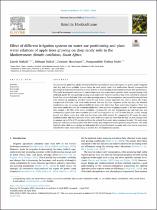| dc.contributor.author | Ntshidi, Zanele | |
| dc.contributor.author | Mazvimavi, Dominic | |
| dc.contributor.author | Mobe, Nompumelelo Thelma | |
| dc.date.accessioned | 2024-02-13T08:04:26Z | |
| dc.date.available | 2024-02-13T08:04:26Z | |
| dc.date.issued | 2023 | |
| dc.identifier.citation | Ntshidi, Z., Dzikiti, S., Mazvimavi, D. and Mobe, N.T., 2023. Effect of different irrigation systems on water use partitioning and plant water relations of apple trees growing on deep sandy soils in the Mediterranean climatic conditions, South Africa. Scientia Horticulturae, 317, p.112066. | en_US |
| dc.identifier.issn | 03044238 | |
| dc.identifier.uri | http://hdl.handle.net/10566/9289 | |
| dc.description.abstract | All commercial apple fruit (Malus Domestica (Borkh) exported from semi-arid regions are grown under irrigation with drip and micro sprinkler systems being the most widely used. Few studies have directly compared the physiological responses of fruit trees to these systems in detail leading to uncertainties around their performance. This study investigated variations in transpiration rates, tree water status, growth, water use partitioning, fruit yield and quality for trees growing on deep sandy soils under these two systems. Data were collected in a mature Royal Gala orchard in South Africa over three growing seasons. Tree transpiration was quantified using the heat ratio method of monitoring sap flow while the soil water balance approach was used to derive the evapotranspiration (ET) rates. Leaf level results showed that one day after irrigation on hot dry days, the stomatal conductance was, on average, almost double for trees under micro than those under drip irrigation. There was more stress under drip with the minimum midday leaf water potential dropping to under -1.80 MPa compared to only around -1.20 MPa under micro sprinklers. Consequently, the tree transpiration per unit leaf area was substantially higher under micro sprinkler (2.9 L/m2 /d) compared to 2.3 L/m2 /d under drip (P ≤ 0.05). Canopy growth was slower under drip with peak leaf area index (LAI) around 2.1 compared to 2.7 under the micro sprinkler system. The micro sprinkler system had a more active ground cover than the drip. At peak canopy cover in summer, up to 28% of ET was derived from the orchard floor under micro compared to only 15% under drip. However, fruit size and fruit quality were lower under drip compared to micro sprinkler irrigated trees. The study highlights that while water savings are high under drip irrigated orchards on sandy. | en_US |
| dc.language.iso | en | en_US |
| dc.publisher | Elsevier | en_US |
| dc.subject | Evaporation | en_US |
| dc.subject | Fruit quality | en_US |
| dc.subject | Fruit yield | en_US |
| dc.subject | Soil water content | en_US |
| dc.subject | Transpiration | en_US |
| dc.title | Effect of different irrigation systems on water use partitioning and plant water relations of apple trees growing on deep sandy soils in the mediterranean climatic conditions, South Africa | en_US |
| dc.type | Article | en_US |

